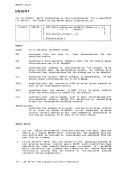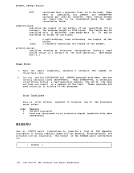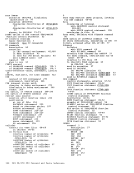DDR • Flagged tracks are treated just as any other track for all 2314, 2319, 3340, and 2305 devices. That is, no attempt is made to
substitute the alternate track data when a defective primary track is
read. In addition, tracks are not inspected to determine whether
they were previously flagged when written. Therefore, volumes
containing flagged tracks should be restored to the same cylinders of
thevolume from which they were dumped. The message
each time a defective track is dumped, copied or restored, and the
operation continues.• Flagged tracks on 3330, and 3350 devices are handled automatically by
the control unit and may never be detected by the program. The
program may detect a flagged trackif, for example, 110 alternate
track is assigned to the defective primary track. If a flagged track
is detected by the program, the message
operation terminates.INPUT 191 3330 SYSRES OUTPUT 180 2400 181 (!'lODE 800 SYSPRINT OOF DU!'lP CPVOL INPUT 130 3330 MINIOl TO 50 REORDER 51 60 70 101 This example sets the density to 800 bpi, then dumps all pertinent
data from the volume labeledSYSRES onto the tape that is mounted on
unit190. If the program runs out of space on the first tape, it
continues dumping onto the alternate device (181).A map of the dumped
cylinders is printed on unitOOF while the program is dumping. When the
first function is complete, the volume labeledMINIOl is dumped onto a
newtape. Its cylinder header records are labeled 51 to A map of
the dumped cylinders is printed on unitOOF. Next, cylinders 60 to 70 are dumped and labeled 101 to 111. This extent is added to the cylinder
map on unitOOF. When the DDR processing is complete, the tapes are
unloaded and the program stops.
If cylinder extents are being defined from the console, the user needonly enter DUMP, COPY or RESTORE on the command line. The following is displayed: ENTER CYLINDER EXTENTS ENTER:
For any extent after the first extent, the message:
ENTEREXTENT OR NULL LINE
ENTER:
is displayed.You may then enter additional extents to be dumped, restored, or
copied.A null line causes the job step to start.
1.When a cylinder map is printed on the virtual printer (OOF as in
the previous example) a heading precedes the map information.Kodule DMrDDR controls the disk, time and zone printed in the
heading.Your installation must apply a local modification to Time), is printed in the heading. Section 2.
substitute the alternate track data when a defective primary track is
read. In addition, tracks are not inspected to determine whether
they were previously flagged when written. Therefore, volumes
containing flagged tracks should be restored to the same cylinders of
the
each time a defective track is dumped, copied or restored, and the
operation continues.
the control unit and may never be detected by the program. The
program may detect a flagged track
track is assigned to the defective primary track. If a flagged track
is detected by the program, the message
operation terminates.
data from the volume labeled
unit
continues dumping onto the alternate device (181).
cylinders is printed on unit
first function is complete, the volume labeled
new
the dumped cylinders is printed on unit
map on unit
unloaded and the program stops.
If cylinder extents are being defined from the console, the user need
For any extent after the first extent, the message:
ENTER
ENTER:
is displayed.
copied.
1.
the previous example) a heading precedes the map information.
heading.






















































































































































































































































































































































































































